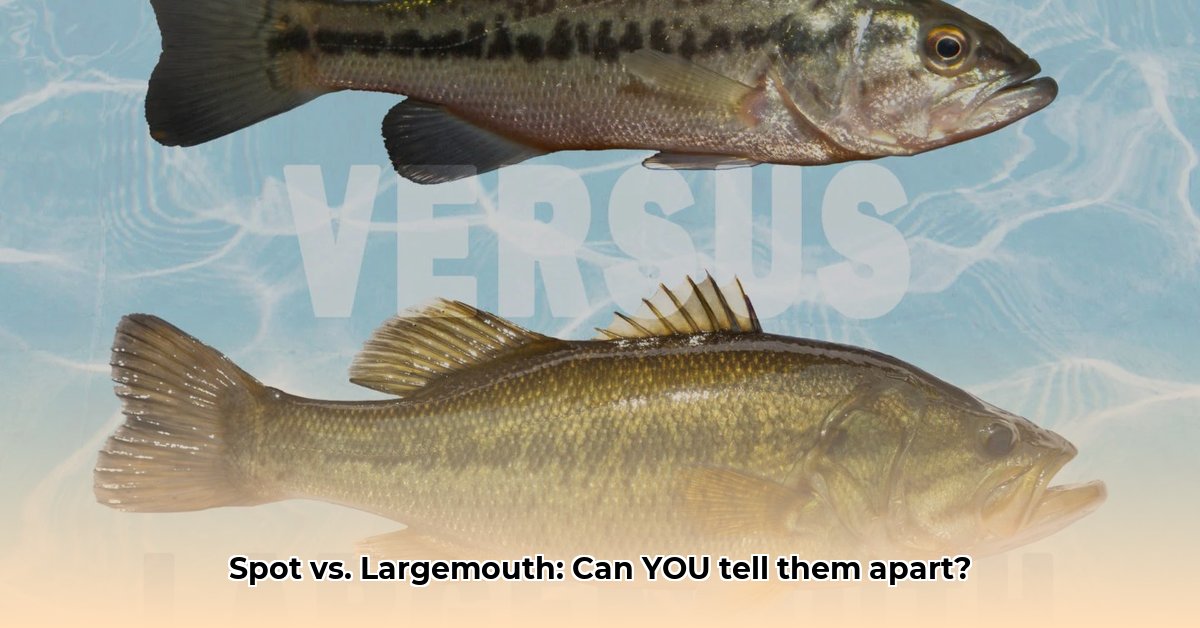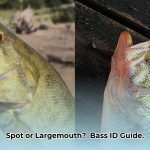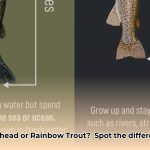This guide provides everything you need to differentiate between spotted and largemouth bass, from quick identification tips to detailed comparisons of their behavior, habitat, and preferred fishing techniques. Whether you’re a beginner angler or a seasoned pro, this guide will enhance your understanding and appreciation of these fascinating fish.
Quick ID: Spotting the Difference
Let’s start with the fastest ways to tell these two bass apart. You’ve just landed a bass – now what?
The Jawline Test
Imagine drawing a line straight down from the fish’s eye. Does the upper jaw extend beyond that line? If so, it’s likely a largemouth bass, showcasing its characteristic “overbite.” If the jaw stops at or before the eye line, you’ve probably caught a spotted bass.
Dorsal Fin Check
The dorsal fin (the one on the back) offers another quick clue. A largemouth’s dorsal fin has a deep notch, almost separating it into two distinct fins. A spotted bass’s dorsal fin has a much shallower notch, appearing more continuous.
In-Depth Comparison: A Bass Detective’s Guide
Ready to dive deeper? These additional characteristics will solidify your identification skills.
Lateral Line Clues
The lateral line, a sensory organ running along the fish’s side, offers further hints. While not always definitive, a spotted bass may have a distinct row of dark spots along its lateral line, living up to its name. A largemouth’s lateral line is typically less prominent and lacks distinct spots.
Scale Size Secrets
Examine the scales on the fish’s cheek. Spotted bass have noticeably smaller cheek scales compared to the scales on the rest of their body. Largemouth bass have more uniform scale sizes.
Tongue Tell
While not always practical on the water, a spotted bass often has a rough patch on its tongue, while a largemouth’s tongue is smooth.
Belly Markings
Flip your catch over (gently!). Spotted bass typically have rows of dark spots on their bellies, which may fade towards the tail. Largemouth bass usually lack these prominent belly markings.
Quick Reference: Key Differences at a Glance
| Feature | Spotted Bass | Largemouth Bass |
|---|---|---|
| Jaw | Stops at or before the eye | Extends beyond the eye |
| Dorsal Fin | Shallow notch, appears continuous | Deep notch, almost two separate fins |
| Lateral Line | May have distinct spots | Usually lacks distinct spots |
| Cheek Scales | Smaller than body scales | Uniform scale size |
| Tongue | Often has a rough patch | Smooth |
| Belly Markings | Rows of spots (may fade) | Few to none |
Habitat and Behavior: Worlds Apart
Understanding where these bass live and how they act is crucial for successful angling.
Spotted Bass: River Dwellers
Spotted bass thrive in cool, clear, flowing water, often found in rivers and streams. They prefer rocky areas, ledges, and other structures that provide cover and break the current. They are active hunters, often schooling and chasing prey.
Largemouth Bass: Lake Lovers
Largemouth bass prefer calmer, warmer waters like lakes and ponds. They gravitate towards vegetation, submerged logs, and other cover where they can ambush prey. They are generally solitary and more opportunistic feeders.
| Feature | Spotted Bass | Largemouth Bass |
|---|---|---|
| Preferred Habitat | Rivers, Streams, Rocky areas, Cooler Water | Lakes, Ponds, Vegetation, Warmer Water |
| Behavior | Active, schools, dives when hooked | Ambush predator, solitary, jumps when hooked |
Ongoing research suggests that these habitat preferences influence their behavior, metabolism, and even their aggressiveness towards lures. Factors like water temperature, clarity, and oxygen levels can also impact their distribution and activity.
Fishing Techniques: Tailoring Your Approach
Knowing the differences between spotted and largemouth bass allows you to refine your fishing techniques.
Targeting Spotted Bass
Use smaller lures and lighter line when fishing for spotted bass in deeper, clearer water. Their active nature means they’re often willing to chase a lure, so presentations with a bit of finesse can be effective.
Targeting Largemouth Bass
For largemouth bass, larger lures and baits presented near cover in shallower water are often successful. Exploit their ambush instincts with slow-moving or stationary presentations.
Tips for Both Species
- Seasonal Adjustments: Bass behavior changes throughout the year. Adjust your techniques accordingly, considering water temperature, spawning periods, and seasonal feeding patterns.
- Observe and Adapt: Pay attention to the environment. What type of cover is present? What is the water clarity and temperature? Adapt your approach based on your observations.
- Ethical Practices: Practice catch and release whenever possible, handling fish gently and minimizing their time out of the water. Adhere to local fishing regulations and size limits.
By continuously learning and refining your techniques, you’ll increase your chances of success and deepen your appreciation for these remarkable fish. Happy fishing!
- Hydro Extrusions USA Leads North American Aluminum Profile Solutions - December 28, 2025
- Hydro North America Leads Aluminum Extrusion Solutions Across Diverse Industries - December 27, 2025
- Hydro Extrusion North America Provides Custom Solutions Across Diverse - December 26, 2025
















